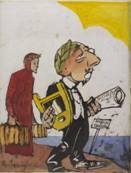Barbed Wit: Italian Satire of the Great War
dal 9/1/2007 al 17/3/2007
Segnalato da
9/1/2007
Barbed Wit: Italian Satire of the Great War
Estorick Collection of Modern Italian Art, London
36 highly-coloured original designs by little-known artists will be on display from the archives of the Imperial War Museum, London. These large-scale drawings will be exhibited alongside a selection of corresponding monochromatic postcards so that the visitor can see the mass-produced outcome beside the original design.

Artwork for postcards produced in Italy during the Great War
Barbed Wit: Italian Satire of the Great War, on view at the Estorick
Collection of Modern Italian Art, 39a Canonbury Square, London N1, from
Wednesday 10 January to Sunday 18 March 2007, presents rarely viewed
original artwork for postcards produced in Italy during the Great War. The
exhibition displays bold designs, biting satire, and a specifically Italian
slant on wartime propaganda.
Thirty-six highly-coloured original designs by little-known artists will be
on display from the archives of the Imperial War Museum, London. These
large-scale drawings will be exhibited alongside a selection of
corresponding monochromatic postcards so that the visitor can see the
mass-produced outcome beside the original design. Postcards first appeared
in Austria from 1869 and became increasingly popular across Europe and
America reaching a ‘golden age’ in the first decade of the 20th century.
They could be printed inexpensively in black and white, to appeal and be
rapidly distributed to a mass public. In addition to the newspapers of the
day, postcards formed an important part of the social and political
commentary on events of the Great War and today they are an important source
of wartime ephemera.
At the outbreak of the Grande Guerra (Great War) in 1914, Italy formed part
of the Triple Alliance, together with Germany and Austria-Hungary, but
argued that an aggressive war did not uphold the terms of the alliance.
Both sides offered land to Italy in exchange for support but she initially
retained her neutrality. This hesitancy to declare an alliance is
satirised in Virgilio Retrosi’s shrewd image of a red-faced Italian
infantryman who ponders whether to follow a signpost to the ‘European
Theatre’. The title of the piece aptly sums up Italy’s dilemma: ‘Shall I
just be an extra or take a starring role?’. The prolonged
vacillation is amplified in another of Retrosi’s works ‘To go or not to go’
which depicts a young woman picking petals off flowers in a universally
recognised, but irrational, method of decision-making.
The Italian Futurists, since their foundation in 1909, had glorified and
advocated participation in war, defining it in their founding manifesto as
‘the sole hygiene of the world’. At the outbreak of World War I, Italy was
divided into neutralists and interventionists with the Futurists vehemently
supporting the latter movement through art and declarations, such as
‘Futurist Synthesis of the War’ and Giacomo Balla’s manifesto ‘The
Anti-neutral Suit’of 1914. In Giulio Gigli’s postcard design he imitates
the style of another Futurist, Gino Severini, in a semi-abstract, dynamic
composition, which merges the national colours of France, Belgium and
Germany, together with bullets, shrapnel and interspersed wording such as
‘misery’ and ‘snow’. The subtitle of this design ‘Dynamic Vision of Befana’
highlights the artist’s prediction of a miserable epiphany for those
countries already involved in the war .
Following the secret Treaty of London in April 1915, Italy, having secured
territorial gains, joined the Triple Entente and officially declared war
against Austria-Hungary on 23 May 1915. Artists used postcards to criticise
the actions or inaction of various sectors of the Italian people during the
war. The prosperous bourgeoisie were typified as materialistic
war-profiteers who lacked patriotic duty. In ‘I have given a lot’
and ‘The Complaining Citizen’, the artist shows his disdain towards
an uncom-mitted and indifferent class, characterised here by a plump,
overdressed Boulevardier.
The designs, whilst demonstrating cutting satire, also show theatrical good
humour in their caricatures of key figures. The German Kaiser Wilhelm II is
depicted as Medusa (fig. 6) whilst Vittorio Emmanuele III is shown in ‘Armed
Neutrality’ as a diminutive figure peeping out of an excessively armoured
suit yet shackled by the chains of indecision. The country’s
flamboyant nationalist poet Gabriele d’Annunzio (1863-1938) was responsible
for a daring propaganda stunt during 1918 when, flying an aeroplane over
Vienna, he scattered red, white and green tinted postcards appealing to the
Viennese to turn on their government. This feat is referred to in Ferro’s
design of 1918 where he cunningly uses a quote from Dante
Alighieri, d’Annunzio’s historical counterpart, Poveri versi miei gettati al
vento (‘My poor verses have been scattered to the wind’).
The artists featured in this exhibition used a variety of different
satirical devices including personification, caricature and bestialisation
to create a sophisticated, shrewd and visually appealing commentary on
Italy’s involvement in the Great War.
The exhibition has been organised in collaboration with the Imperial War
Museum, London. A fully illustrated catalogue will be available with an
essay by art historian Nadia Marchioni (curator of the exhibition La Grande
Guerra degli artisti at Museo Marino Marini, Florence in 2005/6).
Press office:
Sue Bond PR
Hollow Lane Farmhouse, Thurston, Bury St Edmunds
Suffolk, IP31 3RQ Tel: +44 (0) 1359 271085 info@suebond.co.uk
Estorick Collection of Modern Italian Art
39a Canonbury Square - London
Opening hours: Wednesday to Saturday 11.00-18.00 hours, Sunday 12.00-17.00 hours
Admission: £3.50, concessions £2.50.



